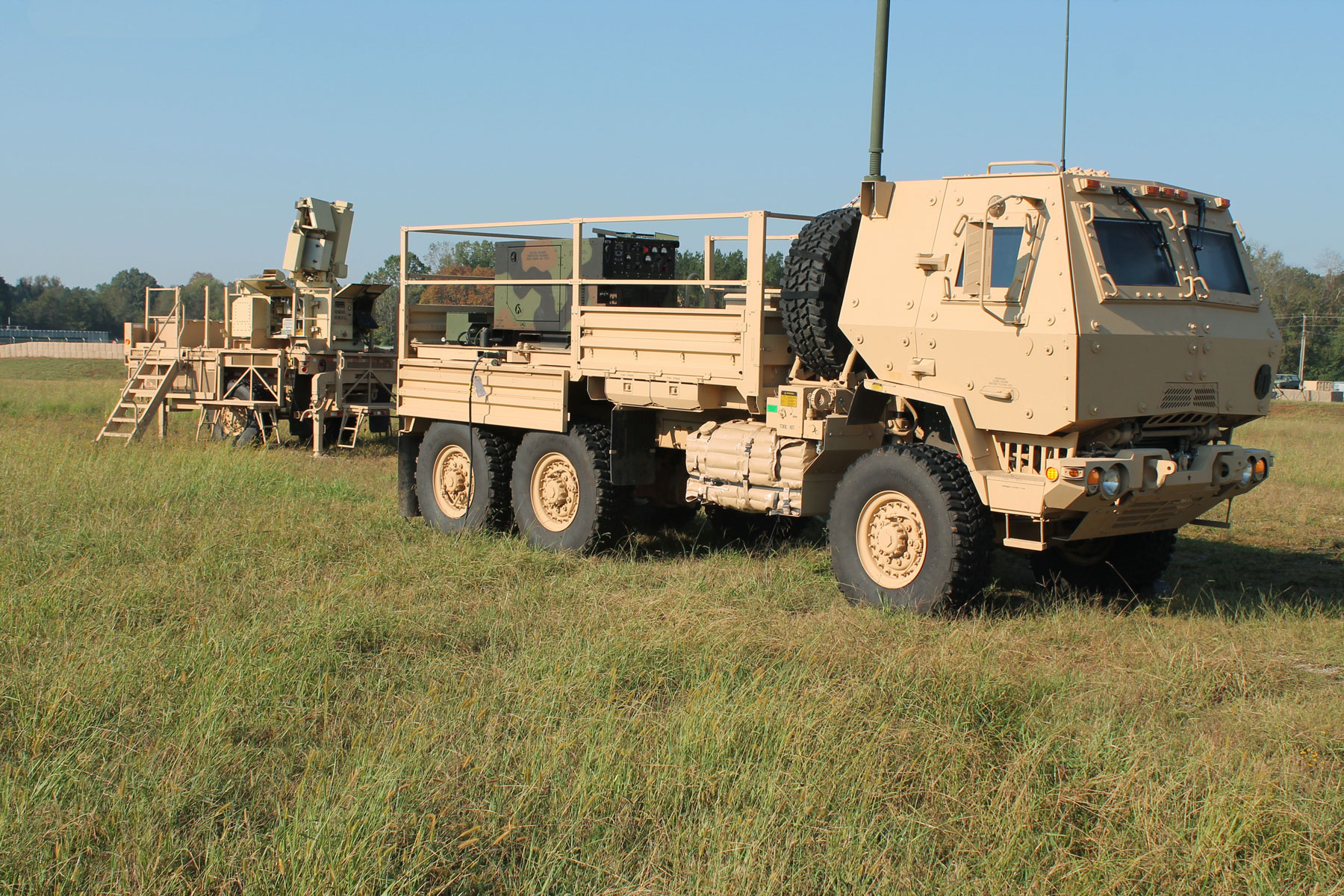
By Michael A. Wilson and Michael J. Glenn
Embracing the Army agile process, the Cruise Missile Defense Systems (CMDS) Project Office’s Sentinel Product Office (SPO), went from early planning, to prototype and then qualification testing of a new Enhanced Sentinel Radar in just over 12 months.
Sentinel will showcase this latest evolution enhancing force protection and Soldier survivability in a roll-out of the AN/MPQ 64A3 Enhanced Sentinel Radar first production unit on a Family of Medium Tactical Vehicles (FMTV) in October at Letterkenny Army Depot, Pa. (LEAD).

AN/MPQ-64 A3 Enhanced Sentinel Radar System is the only 360-degree coverage air defense radar in the Army’s current inventory and features a 3 D X-Band phased array antenna that provides an instrumented range of 75 kilometers. ( U.S. Army photos)
Sentinel is the only 360-degree coverage air defense radar in the Army’s current inventory and features a 3 DX Band phased array antenna that provides an instrumented range of 75 kilometers. The Army previously procured 143 basic Sentinel Radars on the High Mobility Multipurpose Wheeled Vehicle (HMMWV) but through incremental upgrades, the radar has evolved to a more robust system with greater capability.
In FY11, the Army procured 56 additional Enhanced Sentinel A3 radars that will be mounted on the M1082 Light Medium Tactical Vehicle Trailer (LMTV) with support equipment loaded onto the M1083 FMTV. The A3 radars are being produced by Thales Raytheon Systems (TRS) at the Raytheon Consolidated Manufacturing Center at Forest, Miss., while the FMTV truck and LMTV trailer will receive Sentinel specific modifications at LEAD.
The new FMTV platform replaces the current HMMWV that has been in use with the Sentinel radar since 1997 and is capable of hosting an enhanced armor protection kit that signifies a major step forward in providing increased Soldier survivability. The armored FMTV will meet all Sentinel maneuverability and transportability requirements while providing greater protection to the Soldier against today’s battlefield threats. The improved platform also has a larger area for the installation of new equipment that will allow Sentinel to be fully integrated with the Army Integrated Air & Missile Defense (IAMD) systems.

Sentinel will roll-out the AN/MPQ 64A3 Enhanced Sentinel Radar first production unit on a Family of Medium Tactical Vehicles (FMTV) in October 2013 at Letterkenny Army Depot.
The Enhanced Sentinel Radar also has a modernized Radar Control Terminal (RCT) with a Linux-based RCT operating system, adding an Ethernet router for integration with the IAMD architecture. This will integrate the Identification Friend or Foe Mode V capability to prevent fratricide and the need to replace obsolete processor cards.
Design to first production was accomplished at amazing speed and efficiency by using the Army agile process. The SPO at CMDS pursued a government acquisition and development approach using an integrated product team (IPT) that significantly reduced cost and development time. The FMTV Sentinel prototype effort was led by the Aviation & Missile Research, Development & Engineering Center (AMRDEC) Prototype Integration Facility (PIF) at Redstone Arsenal, Ala. along with the IPT.
This IPT partnership comprised members from the PIF; designers from Intuitive Research and Technology Corporation and Yulista Management Services (subcontractors to the PIF); manufacturing engineers and tradesmen from LEAD; safety engineers from the Army Research Laboratory and CMDS; maintenance personnel from the Fire Center of Excellence; system engineers and logisticians from TRS (the developer and manufacturer of the radar); and representatives from CMDS in various engineering disciplines, logisticians and program management. By using this unique method, the Sentinel team went from the early planning stage to having a completed prototype and moving into qualification testing in just over 12 months. This approach reduced the manufacturing lead time and cost by allowing LEAD to input required changes in the design tailored to their processes and process capabilities, input to material and vendor selection, and plan for life-cycle support requirements.

The new FMTV platform replaces the current HMMWV that has been in use with the Sentinel radar since 1997 and is capable of hosting an enhanced armor protection kit that signifies a major step forward in providing increased Soldier survivability. Fielding 56 new systems is scheduled to begin in FY14.
The IPT partnership approach allowed for quick incorporation of changes resulting from development and test activities to be optimized and integrated into the production line in substantially less time and at significantly less cost than previous development efforts. In addition, this reduced the number of design changes since major stakeholders were encouraged to provide input on the design on a weekly basis rather than at traditional preliminary and critical design reviews. This process also allowed the Sentinel product director to identify and abate program risks much quicker than in a normal program execution. Overall, the Army agile process has allowed the SPO to develop, build, test, and transition into production, an FMTV-based Sentinel in less time, with fewer redesigns and at less cost to the government than a typical Army system acquisition.
Fielding the 56 new production systems is scheduled to begin in fiscal year 2014, and an effort to replace the current HMMWV platform with the new FMTV for the entire Sentinel fleet is planned from fiscal year 2014 through fiscal year 2018.
The October roll-out of the AN/MPQ-64A3 Enhanced Sentinel Radar’s first new-production radar will be another step in the Sentinel Radar evolution. This signifies a major step in providing enhanced surveillance data to shooters in the IAMD architecture, increased Soldier survivability, and proven viability of the Army’s agile acquisition process.







